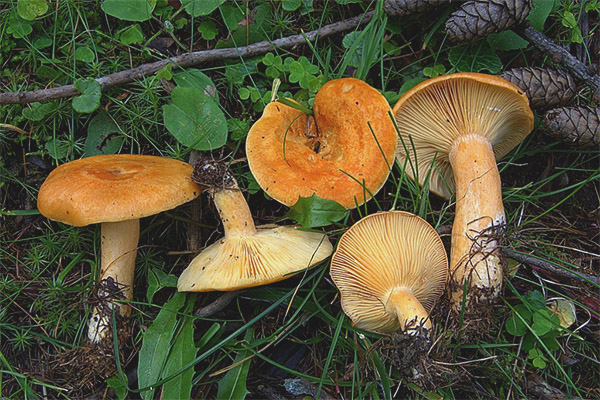The content of the article
Orange mlechnikov is considered to be an inedible type of the Russula family. These fruiting bodies are regular lacteas, releasing caustic sap. Despite the pleasant smell emanating from the mushrooms, these specimens are inedible. Their consumption in food can be unpredictable. Even in folk medicine such mushrooms are not used. Let us examine all aspects and characteristics associated with the orange representatives of the family.
Description
- A hat in diameter can be up to 8 cm, but in fact the tip does not grow more than 6 cm. The bottom height is on average about 5 cm. With a width of 2 cm. There are plates on the inside of the hat. They are not too wide, but not narrow, they are located close to each other, slightly lowered. The plates contain spore powder colored yellow.
- In young, the tops stick out.However, over time, they cracked down and become dented format. In the end, the mushroom hat becomes like a funnel. The upper part has an orange peel. It is smooth, matte with a slight shine in a chaotic manner. When growing in moisture it becomes slippery.
- Leg on the cylinder format. Tapers to the bottom. In youngsters it is lightened, similar in shade to a hat. When a mushroom grows and becomes mature, its base finds emptiness inside. These mushrooms emit a lot of juice, which is distinguished by its density. It is sticky, caustic, painted in a light tone, does not change in color when shaved. Pulp with fibers, smells like orange.
Sprouting
- Fruit bodies prefer to live in larches. They can be found, growing in proud loneliness or groups of small size. Fruiting begins in summer, ends in autumn. Mycorrhiza is formed with hardwood trees.
- This variety is inedible. Moreover, according to some mycologists, the orange members of the family are considered even slightly toxic.There is no danger to life, but consumption leads to disorders of the gastrointestinal tract.
Brownish Mlechnik
- The fungus is classified as conditionally edible. The top in diameter reaches 12 cm. Maximum, but there are instances on average of 5-10 cm. The hat is colored with a chocolate shade, it quickly breaks. The edges hem up, the tip itself becomes depressed over time. Feels velvet.
- The base can be up to 11 cm in length. It is dyed brown, beige or white. The format is cylindrical. The plates on the inside of the hat are closely spaced, painted with ocher or pink pigment.
- The soft part quickly breaks, it is very fragile and white. If you make a cut, then when the weathering is done the flesh will mutate and become pinkish in this area. It smells delicious berries, no bitterness. Look for copies needed in Europe. They bear fruit from mid-summer to early autumn.
- This mushroom is considered conditionally edible, because it is eaten more often than other varieties. Copies are salted and dried. However, these mushrooms are eaten in the open spaces of our country, they do not eat them in European countries.
Faded Mlechnik
- One more conditionally edible specimen that grows up to 9 cm in diameter of the hat. The top is colored purple, gray or purple. It may be gray-brown, but over time becomes whitish. Slightly bulges, then flattens out.
- In the central part the top is concave, dark. Along the edges, which are folded inward, light. The skin is not straightened, it feels slightly moist and sticky, leaves and branches are constantly glued.
- The base bends, but may be even. The height grows up to 8 cm. It is dyed light brown or white, a little lighter than a hat. According to the format of the leg, like a cylinder.
- The soft part is greyish or whitish. From it stands out juice. It is fragile, may break when pressed or mistreated. Plates are close, they are thin and frequent. Pigmented ocher or creamy tone, with pressure turn gray.
- You need to look for mushrooms, starting from the end of summer, ending in mid-autumn. They live in a mixed strip and larches. Often found near birch trees, areas near the swamp are considered favorite places.
In today's article, we studied the orange representative of the family, as well as other specimens related to Mlechnik. Orange fruit bodies are not consumed in food, which cannot be said about their companions (conditionally edible). The main thing is to be able to isolate quality specimens from everyone else, so as not to collect a basket of unnecessary fruit bodies.
Video: orange crab (Lactarius porninsis)












To send